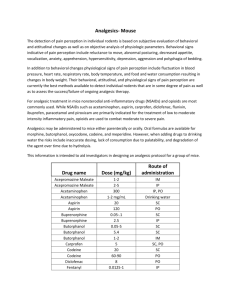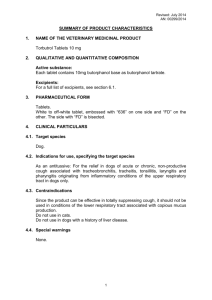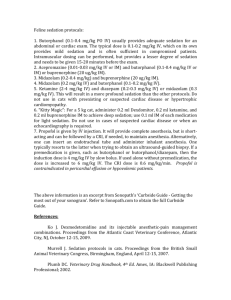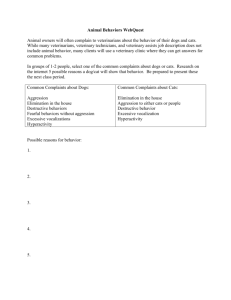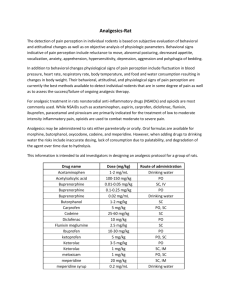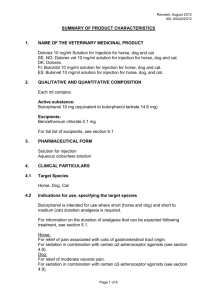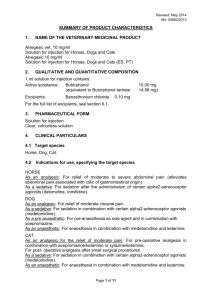summary of product characteristics
advertisement
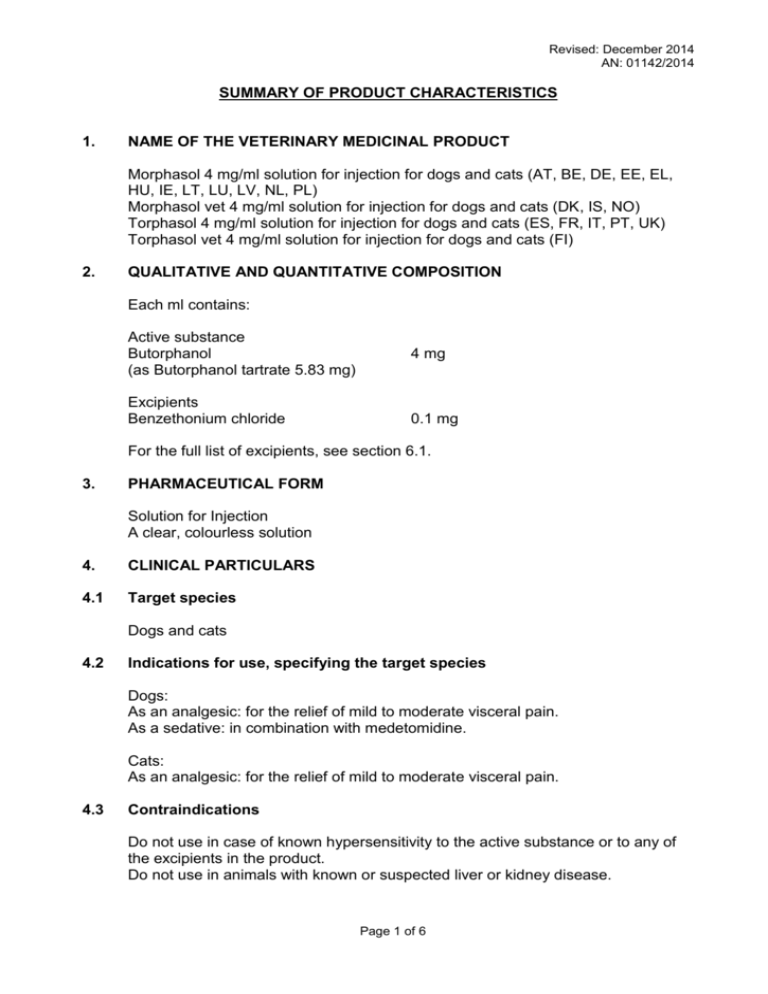
Revised: December 2014 AN: 01142/2014 SUMMARY OF PRODUCT CHARACTERISTICS 1. NAME OF THE VETERINARY MEDICINAL PRODUCT Morphasol 4 mg/ml solution for injection for dogs and cats (AT, BE, DE, EE, EL, HU, IE, LT, LU, LV, NL, PL) Morphasol vet 4 mg/ml solution for injection for dogs and cats (DK, IS, NO) Torphasol 4 mg/ml solution for injection for dogs and cats (ES, FR, IT, PT, UK) Torphasol vet 4 mg/ml solution for injection for dogs and cats (FI) 2. QUALITATIVE AND QUANTITATIVE COMPOSITION Each ml contains: Active substance Butorphanol (as Butorphanol tartrate 5.83 mg) Excipients Benzethonium chloride 4 mg 0.1 mg For the full list of excipients, see section 6.1. 3. PHARMACEUTICAL FORM Solution for Injection A clear, colourless solution 4. CLINICAL PARTICULARS 4.1 Target species Dogs and cats 4.2 Indications for use, specifying the target species Dogs: As an analgesic: for the relief of mild to moderate visceral pain. As a sedative: in combination with medetomidine. Cats: As an analgesic: for the relief of mild to moderate visceral pain. 4.3 Contraindications Do not use in case of known hypersensitivity to the active substance or to any of the excipients in the product. Do not use in animals with known or suspected liver or kidney disease. Page 1 of 6 Revised: December 2014 AN: 01142/2014 Use of butorphanol is contraindicated in case of cerebral injury or organic brain lesions and in animals with obstructive respiratory diseases, heart dysfunction or spastic conditions. 4.4 Special warnings for each target species Butorphanol is intended for use where short (dog) and short to medium (cat) analgesia is required. For information on the duration of analgesia that can be expected following treatment, see section 5.1. However, repeat treatments of butorphanol may be administered. For cases where longer duration analgesia is likely to be required, an alternative therapeutic agent should be used. The safety of the product in young puppies and kittens has not been established. Use of the product in these groups should be on the basis of a benefit: risk analysis by the responsible veterinarian. In cats, individual response to butorphanol may be variable. In the absence of an adequate analgesic response, an alternative analgesic agent should be used. In cats, increasing the dose may not increase the intensity or duration of analgesia. 4.5 Special precautions for use i. Special precautions for use in animals Routine cardiac auscultation should be performed prior to use in combination with α2-adrenoceptor agonists. The combination of butorphanol and α2-adrenoceptor agonists should be used with caution in animals with cardiovascular disease. The concurrent use of anticholinergic drugs, e.g atropine should be considered. In cases of respiratory depression, it can be reversed by an opioid antagonist (e.g. Naloxone). Sedation may be noted in treated animals. Due to the antitussive properties of butorphanol, it should not be used in combination with an expectorant or in animals with respiratory disease associated with increased mucous production, as this may lead to accumulation of mucous in the airways. Cats should be weighed to ensure that the correct dose is calculated. Use of either insulin syringes or 1 ml graduated syringes is recommended. ii. Special precautions to be taken by the person administering the medicinal product to animals Direct contact with skin or eye of the user should be avoided. Care should be taken when handling the product to avoid self-injection. Accidental spillage on the skin should be washed immediately with soap and water. When the product comes into contact with the eyes, rinse immediately with plenty of water. In case of accidental self-injection, seek medical advice immediately and show the package insert or the label to the physician, and DO NOT DRIVE, since drowsiness, nausea and dizziness may occur. Effects can be reversed by the administration of an opioid antagonist. Page 2 of 6 Revised: December 2014 AN: 01142/2014 4.6 Adverse reactions Dogs: Mild sedation may occur. Respiratory and cardiovascular depression may occur. Reduction in gastrointestinal motility may occur. Transient ataxia, anorexia and diarrhoea occur rarely. Cats: Mild sedation may occur. Respiratory and cardiovascular depression may occur. Mydriasis is likely to occur. Disorientation, agitation, anxiousness, restlessness and increased sensitivity to noise may occur. 4.7 Use during pregnancy, lactation or lay The safety of the product has not been established in the target species during pregnancy and lactation. The use of butorphanol during pregnancy and lactation is not recommended. 4.8 Interaction with other medicinal products and other forms of interaction Butorphanol may be used in combination with other sedatives such as α2adrenoceptor agonists (e.g. medetomidine in dogs) where synergistic effects can be expected. Therefore, an appropriate reduction in dose is necessary when used concomitantly with such agents (see section 4.9). Because of the antitussive properties of butorphanol, it should not be used in combination with an expectorant, as this may lead to an accumulation of mucous in the airways. The concomitant use of α2-agonists may decrease gastrointestinal motility. Because of its antagonist properties at the opiate mu (µ) receptor butorphanol may remove the analgesic effect in animals, which have already received pure opioid mu (µ) agonists (morphine/oxymorphine). 4.9 Amount(s) to be administered and administration route Dogs: Analgesia: intravenous administration of 0.2-0.4 mg/kg bodyweight (BW) butorphanol (equivalent to 0.05-0.1 ml/kg BW). For postoperative analgesia intravenous administration of 0.2-0.4 mg/kg BW butorphanol is recommended 20 minutes prior to end of soft tissue surgery. Sedation in combination with medetomidine: intravenous administration of 0.1-0.2 mg/kg BW butorphanol (equivalent to 0.0250.05 ml/kg BW ) with 10-30 μg/kg BW medetomidine, depending on degree of sedation required. Page 3 of 6 Revised: December 2014 AN: 01142/2014 Cats: Analgesia: intravenous administration of 0.1-0.2 mg/kg BW butorphanol (equivalent to 0.0250.05 ml/kg BW) Avoid rapid intravenous injection. Butorphanol is intended for use where short (dog) and short to medium (cat) analgesia is required. For information on the duration of analgesia that can be expected following treatment, see section 5.1. However, repeat treatments of butorphanol may be administered. The need for, and timing of repeat treatment should be based on clinical response. For cases where longer duration analgesia is likely to be required, an alternative therapeutic agent should be used. In the absence of an adequate analgesic response (see section 4.4), use of an alternative analgesic agent, such as another suitable opioid analgesic and/or a non-steroidal anti-inflammatory drug, should be considered. Any alternative analgesia should take account of the action of butorphanol on opioid receptors, as described in Section 4.8. 4.10 Overdose The main sign of overdose is respiratory depression, which can be reversed with an opioid antagonist (e.g. Naloxone). 4.11 Withdrawal period Not applicable. 5. PHARMACOLOGICAL PROPERTIES Pharmacotherapeutic group: Synthetic opioid (morphinan derivatives), centrally acting analgesic. ATCvet Code: QN02AF01 5.1 Pharmacodynamic properties Butorphanol tartrate is a synthetic opioid, with agonist - antagonist action at the opiate receptors in the central nervous system. It possesses agonist activity at the kappa receptor subtype which control analgesia, sedation without depression of the cardiopulmonary system or body temperature. It has antagonist activity at the mu receptor subtype which controls analgesia, sedation, depression of the cardiovascular system and body temperature. It also possesses weak affinity to the δ-receptors, which may occasionally cause dysphoria. The agonist component is ten times more potent than the antagonist component. The analgesic effect of butorphanol occurs within 15 minutes following intravenous administration in dogs and cats and lasts from 15 minutes up to 30 minutes in dogs. The duration of effect lasts for 15 minutes up to 6 hours in cats. Duration of effect in cats relates to visceral pain only. In cats with somatic pain the duration of effect is likely to be considerably shorter. Page 4 of 6 Revised: December 2014 AN: 01142/2014 5.2 Pharmacokinetic particulars The volume of distribution after intravenous injection is large (7.4 l/kg for cats and 4.4 l/kg for dogs) suggesting wide distribution into tissues. The terminal half-life of butorphanol is short: 4.1 hours for cats and 1.7 hours for dogs. Butorphanol is metabolised extensively in the liver and mainly excreted in urine. 6. PHARMACEUTICAL PARTICULARS 6.1 List of excipients Benzethonium chloride Citric Acid Monohydrate Sodium Citrate Sodium Chloride Water for Injections 6.2 Incompatibilities In the absence of compatibility studies, this veterinary medicinal product must not be mixed with other veterinary medicinal products. 6.3 Shelf-life Shelf-life of the veterinary medicinal product as packaged for sale: 3 years Shelf-life after first opening: 28 days 6.4 Special precautions for storage This veterinary medicinal product does not require any special storage conditions. 6.5 Nature and composition of immediate packaging Cardboard box with 1 glass vial (type I) of 10 ml with a grey butyl rubber stopper and an aluminium cap. Cardboard box with 5 glass vials (type I) of 10 ml with grey butyl rubber stopper and an aluminium cap. Not all pack sizes may be marketed. 6.6 Special precautions for the disposal of unused veterinary medicinal product or waste materials derived from the use of such products, if appropriate Any unused veterinary medicinal product or waste materials derived from such veterinary medicinal products should be disposed of in accordance with local requirements. Page 5 of 6 Revised: December 2014 AN: 01142/2014 7. MARKETING AUTHORISATION HOLDER aniMedica GmbH Im Südfeld 9 48308 Senden-Bösensell Germany 8. MARKETING AUTHORISATION NUMBER Vm 24745/4005 9. DATE OF FIRST AUTHORISATION Date: 10 December 2009 10. DATE OF REVISION OF THE TEXT Date: December 2014 Approved: 14 January 2014 Page 6 of 6
